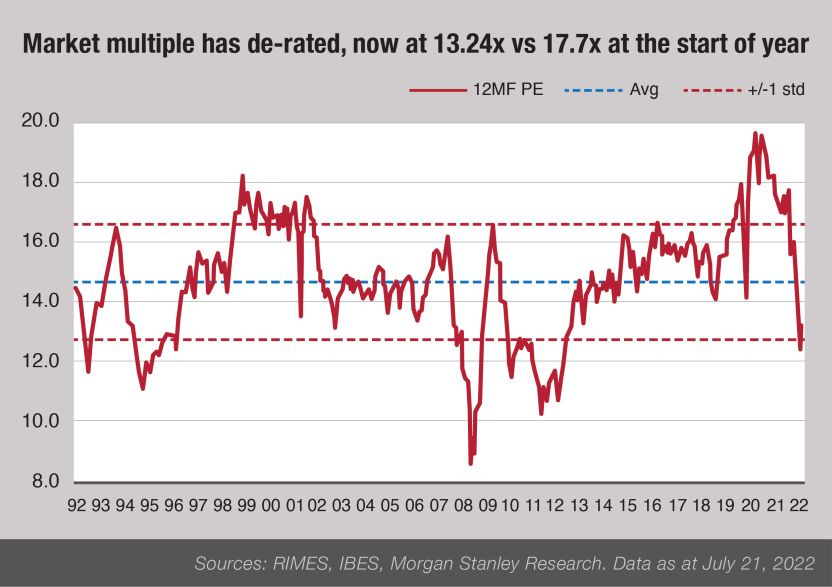August Preview: Curve balls, profits and forecasts
If I were to make a good-humoured attempt at an old fashioned Dad-joke, I'd start off with:
I am old enough to remember when corporate reporting season in Australia was all about profits, margins, dividends and forward-looking guidance.It's not as if reporting seasons in the past have never been closely intertwined with macro-geopolitical, macro-financial or macro-economic concerns. But ever since the early days of the pandemic in 2020, corporate results season in Australia has never been simply about corporate health and profits.
If it wasn't about the virus, or societal lockdowns, the key underpinnings of share price trends have been the return of inflation followed by the normalisation in global bond yields.
The power of all four has proven extremely dominant throughout the past five results seasons and ahead of August, investor consensus is for a global recession on the horizon (domestic Australia not included).
We don't know yet the exact timing or what will be the severity of the upcoming economic slump. But corporate results will definitely be assessed against the background of (much) tougher conditions ahead.
That is, unless central bankers declare the war on inflation is due for a pause and they stop their rigorous tightening, which adds yet another macro factor into the mix.
An end to the war in Ukraine could be another macro catalyst, albeit an unlikely one.
A bargain hunter's paradise
At face value, the Australian share market looks like a bargain hunter's paradise. The market's average Price-Earnings (PE) ratio starts at 13 times, while the average dividend yield has risen to 5% on the back of sharply weaker share prices for large segments of the ASX.
The long-term average PE in Australia is 14.9 times, including a few years of very high valuations. Prior to those years of elevated multiples, the average PE stood at 14.5 times - which is still a long way off today's multiple.

The problem with today's average is that commodity producers are enjoying exceptionally favourable conditions. Investors have responded to this with low valuation multiples (as they traditionally tend to do when confronted with peak-of-the-cycle earnings and cash flows).
BHP Group ASX:BHP shares, for example, with circa 11% the largest index weight in Australia, are trading on 7 times next year's forecast earnings per share.
Shares in Rio Tinto ASX:RIO are on 7.3 times.
For Fortescue Metals ASX:FMG the comparable multiple is only 6.3 times. The numbers look pretty similar for the large caps in the local energy sector.
Following the commodities resurgence post late-2020, mining and energy now represent the second largest group in the local index, after banks/financials.
Any experienced and astute investor knows such low PE multiples are not by default a signal of severe undervaluation; they are merely a sign that investors worry about the two years ahead. But having low PEs for such a large index constituent does depress the overall average, artificially creating the impression of a "cheaply" priced share market.
In the largest group, the banks are mostly trading on below-average multiples too; once again showing the market is concerned about RBA rate hikes, their impact on local housing and the subsequent impact on spending and the local economy in general.
Excluding the two largest index sectors, the average PE in Australia quickly rises above 20x, which, by contrast, still doesn't look that cheap at all.
What's the right valuation?
The biggest problem investors are facing today is figuring out
what is the correct valuation for companies that mostly have no track record in dealing with an economic recession. For multiple reasons, the brief recession of 2020 is hardly a reliable reference point.
Sharply higher bond yields, tighter liquidity, and high inflation – albeit gradual – on economies and companies so far this year have made things even more difficult.
At the same time, supply chain bottlenecks seem to be easing and lockdowns outside China are now a thing of the past, but the pandemic is not.
Combine all of the above and August seems too early to reveal the full impact for every company on the ASX.
With fast-moving share markets having de-rated large segments of the exchange, including retailers, small cap technology, building and construction materials, steel producers, gold miners, property trusts (REITs), mortgage brokers, you might think the bias is leaning towards upside surprises this season.
The current pre-season has already provided a number of examples with explosive share price rallies in response. Think Audinate Group (AD8), Megaport (MP1), Nanosonics (NAN), and WiseTech Global (WTC), among numerous others.
But the current set-up is by no means an invitation to go all-out on high risk positioning, with plenty of others generating steep losses, including Allegiance Coal
ASX:AHQBega Cheese
ASX:BGA, Nitro Software
ASX:NTOand just about every small and mid-cap gold producer out there.
At face value,
corporate Australia looks positioned for an above-average performance this month. Profits for shareholders are projected to have grown by 20%-plus, while dividends are expected to come in near an all-time record high but recent caution by the board of Rio Tinto signals this year's numbers are best not taken for granted.
Similar caution is already reflected in today's consensus forecasts which, mostly, reflect the view commodity producers have at best one more year of 'exceptional' in front of them. Forecasts differ as to how favourable exactly the coming 12 months might still turn out for BHP, Woodside and their peers, but FY24 has negative growth penciled in.
The dilemma as how best to position for the upcoming economic recession yes/no, this year/next year, mild/more severe is not limited to miners and oil and gas producers, but easily extends to local retailers, both bricks and mortar and 100% online.
Judging from recent market updates by JB Hi-Fi ASX:JBH and Accent Group ASX:AX1 the day-to-day dynamics for these companies vary widely even without much of a noticeable correction in house prices as is now widely assumed to happen over the 18 months ahead.
Investors should also note: while dividend payouts are anticipated to remain strong, total payouts in Australia are highly concentrated with the big four banks and big three miners representing 60% of the total forecast FY22 dividend payout.
Current market estimates are for significantly lower EPS growth in FY23 and FY24, with the number for each year in single digit, and with more downgrades yet to follow.
Brokers are sceptical
While just about everyone expects to see net downgrades to growth forecasts over the weeks ahead, there's plenty of disagreement on the magnitude of what should be expected, and priced in, in terms of slower growth in FY23.
Analysts at Citi, for example, expect economic recession in all of the major economic regions of the UK, Europe and the USA (with China to miss its own target), but they also expect corporate profits to prove relatively resilient, which should reduce further downside potential for equity markets worldwide.
Their peers at Macquarie, however, continue to see (a lot) more downside, but they also anticipate a stronger-for-longer environment for the cyclical commodities.
Not all answers will be provided through company performances this month. But one observation stands: research analysts have been showing their short-term scepticism throughout June and July in responses to corporate market updates that can probably be best summarised as:
Okay for now, but what does it look like in 6-12 months' time?
I suspect the same question will be on institutional investors' mind throughout the August season.
Which is why I suspect many share prices will not necessarily follow through on early positive responses to better-than-expected performances.
Whereas the past suggests better-than-forecast corporate results can support share price outperformance for up to four months, this time around the dynamic might be fundamentally different.
The difference comes down to that key question: how resilient are these profits and margins under rough weather?
The oft mentioned credo is that, ultimately, share markets take their guidance from, and follow in the footsteps of corporate profits.
This is only half true, at best.
In practice,
share markets move in the direction of where forecasts of corporate profits are pointing towards. The two are not by default the same. This is why, on occasion, macro considerations overwhelm bottom-up reality.
By mid-2022, market forecasts have now started to fall in Europe, the US and locally in Australia too.
For the US specifically, media and commentators steadfastly mention percentages of "beats" and "misses" but the real statistic to pay attention to is how corporate results impact on analysts' forecasts post the event.
On Macquarie's observations, Q2's share of "misses" from US result releases is currently 4 times higher than in Q2 last year and double the percentage in Q1, with downgrades to forecasts outnumbering upgrades by 2 to 1.
Plus more than half (56%) of S&P500 companies missed analyst expectations on free cash flow; the number of misses rises to 59% for operating cash flow.
Free cash flow, points out Macquarie, is an important, big "miss" given valuations in the US are more closely tied in with cash flows than they are in Australia.
Macquarie's notes might prove important later in the year as some of the more downbeat forecasters (Mike Wilson at Morgan Stanley, David Rosenberg, et al) consider the Q2 reporting season in the US as simply the first in a succession of disappointing quarterly seasons.
Macquarie also notes 47% of S&P500 results to date have revealed higher-than-expected inventories.
In Europe, businesses are on average beating forecasts for sales, but triggering downgrades because of margin pressure.
****
As things stand at the beginning of August, analysts' forecasts are lowest for your typical retailer, with negative profit growth only followed by (on average) marginal growth in the two years ahead. Food and Staples companies are projected to fare much better.
Healthcare is expected to be its historically resilient self, but internally a wide diversion has opened up between, say, CSL ASX:CSL, ResMed ASX:RMD and Pro Medicus ASX:PME on the positive side and Integral Diagnostics ASX:IDX, Healius ASX:HLS and Sonic Healthcare ASX:SHL in (anticipated) struggle street.
In between sits perennial promise Ramsay Health Care ASX:RHC, also constantly under private equity interest.
A big year is projected for insurers in FY23, whereas diversified financials, which includes local asset managers, carry very low expectations. Real estate looks similar to healthcare: resilient as a sector, with large divergence internally.
Technology, believe it or not, is expected to continue to generate robust growth numbers in August and the years ahead, but probably needless to make the point: this sector is beset with all kinds of variaties, ranging from very high but slowing (WiseTech Global) to reliably consistent (TechnologyOne ASX:TNE) to long-term potential with risk and question marks (Megaport) and not-sure-what-to-believe-anymore (Damstra Holdings ASX:DTC).
Somewhere in between sits the currently very popular Audinate Group.
As far as the banks are concerned, nothing spectacular is expected with the debate raging about how much benefit exactly will flow through to the bottom line from a higher cash rate and how much impact should be accounted for when property dynamics change for the worse, even if only for a limited time?
Recent research updates have become noticeably less optimistic on international travel and higher-for-longer oil prices.
Self-declared oil bears at Citi, for example, are now working off average Brent oil price forecasts of US$98.5/bbl and US$75.3/bbl for 2022 and 2023 and by 2025 the low is projected at US$51/bbl.
FNArena offers genuinely independent, impartial, ahead-of-the-curve share market analysis and research, on top of proprietary data, tools and applications for self-managing and self-researching investors.
The service can be trialed at (VIEW LINK)
5 topics
19 stocks mentioned

